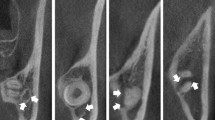Abstract
Purpose
Inferior alveolar nerve injury is a common complication following mandibular third molar extraction. Accurate pre-operative assessment of the anatomical relationship between the mandibular third molar and the mandibular canal could help to avoid this injury. We performed a eta-analysis to investigate whether panoramic radiography could be used to assess the relationship between these two structures.
Methods
PubMed, EMBASE, SpringerLink, Cochrane Library, and Web of Science databases were searched independently by two researchers from January 2008 to May 2018.
Results
Seven articles were identified. Statistical analyses were performed using Revman 5.3 and Meta-disc 1.4 software tools. The pooled sensitivity and specificity were 0.19 (95%CI:0.16–0.22) and 0.90 (95%CI:0.88–0.92), respectively. The pooled positive likelihood ratio and negative likelihood ratio were 2.34 (95%CI:1.42–3.87) and 0.86 (95%CI:0.78–0.96), respectively. The area under the curve was 0.86 (95%CI:0.78–0.96).
Conclusions
According to the sign of narrowing of the mandibular canal, panoramic radiology used to assess the relationship between the mandibular third molar and the mandibular canal yielded high specificity, but low sensitivity. The absence of narrowing of the mandibular canal indicated that there was no close contact between these two structures. However, the presence of narrowing of the mandibular canal could not be used to accurately evaluate the relationship between these two structures, although it might indicate a high probability of close anatomical contact between these two structures. Further tests should be performed for providing adequate pre-operative risk assessment while planning for the surgery to reduce the risk of inferior alveolar nerve injury, as well as to enable an open discussion with the patient to decrease the risk of medical disputes.






Similar content being viewed by others
References
Ali AS, Benton JA, Yates JM. Risk of inferior alveolar nerve injury with coronectomy vs surgical extraction of mandibular third molars—a comparison of two techniques and review of the literature. J Oral Rehabil. 2018;45:250–7.
Agbaje JO, Heijsters G, Salem AS, Van Slycke S, Schepers S, Politis C, et al. Coronectomy of deeply impacted lower third molar: incidence of outcomes and complications after one year follow-up. J Oral Maxillofac Res. 2015;6:e1.
Winstanley KL, Otway LM, Thompson L, Brook ZH, King N, Koong B, et al. Inferior alveolar nerve injury: correlation between indicators of risk on panoramic radiographs and the incidence of tooth and mandibular canal contact on cone-beam computed tomography scans in a Western Australian population. J Investig Clin Dent. 2018;9:e12323.
Renton T, Al-Haboubi M, Pau A, Shepherd J, Gallagher JE. What has been the United Kingdom’s experience with retention of third molars? J Oral Maxillofac Surg. 2012;70:48–57.
Rodriguez YBR, Beltrami R, Tagliabo A, Rizzo S, Lupi SM. Differences between panoramic and cone beam-CT in the surgical evaluation of lower third molars. J Clin Exp Dent. 2017;9(2):e259-e65.
Garmon WB, Jennifer MR, Rebecca JG, Kelly LE, Michael RH, Matthew LD, et al. The accuracy of dental panoramic tomographs in determining the root morphology of mandibular third molar teeth before surgery. Oral Surg Oral Med Oral Pathol Oral Radiol Endod. 2003;95:119–25.
Kim HG, Lee JH. Analysis and evaluation of relative positions of mandibular third molar and mandibular canal impacts. J Korean Assoc Oral Maxillofac Surg. 2014;40:278–84.
Luo Q, Diao W, Luo L, Zhang Y. Comparisons of the computed tomographic scan and panoramic radiography before mandibular third molar extraction surgery. Med Sci Monit. 2018;24:3340–7.
Nakamori K, Fujiwara K, Miyazaki A, Tomihara K, Tsuji M, Nakai M, et al. Clinical assessment of the relationship between the third molar and the inferior alveolar canal using panoramic images and computed tomography. J Oral Maxillofac Surg. 2008;66:2308–13.
Kim JW, Cha IH, Kim SJ, Kim MR. Which risk factors are associated with neurosensory deficits of inferior alveolar nerve after mandibular third molar extraction? J Oral Maxillofac Surg. 2012;70:2508–14.
Şekerci AE, Şişman Y. Comparison between panoramic radiography and cone-beam computed tomography findings for assessment of the relationship between impacted mandibular third molars and the mandibular canal. Oral Radiol. 2013;30:170–8.
Kursun S, Hakan KM, Bengi O, Nihat A. Use of cone beam computed tomography to determine the accuracy of panoramic radiological markers: a pilot study. J Dent Sci. 2015;10(2):167–71.
Ilkay P, Cigdem S, Meryem TA, Zeynep FZ. Panoramic radiography and cone-beam computed tomography findings in preoperative examination of impacted mandibular third molars. BMC Oral Health. 2014;14:71.
Huang CK, Lui MT, Cheng DH. Use of panoramic radiography to predict postsurgical sensory impairment following extraction of impacted mandibular third molars. J Chin Med Assoc. 2015;78:617–22.
Elkhateeb SM, Awad SS. Accuracy of panoramic radiographic predictor signs in the assessment of proximity of impacted third molars with the mandibular canal. J Taibah Univ Med Sci. 2018;13:254–61.
Suomalainen A, Ventä I, Mattila M, Turtola L, Vehmas T, Peltola JS. Reliability of CBCT and other radiographic methods in preoperative evaluation of lower third molars. Oral Surg Oral Med Oral Pathol Oral Radiol Endod. 2010;109:276–84.
Leung YY, Cheung LK. Correlation of radiographic signs, inferior dental nerve exposure, and deficit in third molar surgery. J Oral Maxillofac Surg. 2011;69:1873–9.
Jung YH, Nah KS, Cho BH. Correlation of panoramic radiographs and cone beam computed tomography in the assessment of a superimposed relationship between the mandibular canal and impacted third molars. Imaging Sci Dent. 2012;42:121–7.
Author information
Authors and Affiliations
Corresponding authors
Ethics declarations
Conflict of interest
Author Qin Liye, Author Zhou Zhongwei, Author Sun Xiaojuan, Author Wang Min, Author Liu Pingping and Author Cao Kun declare that they have no conflict of interest.
Ethical approval
All procedures followed were in accordance with the ethical standards of the responsible committee on human experimentation (institutional and national) and with the Helsinki Declaration of 1975, as revised in 2008 (5).
Additional information
Publisher’s Note
Springer Nature remains neutral with regard to jurisdictional claims in published maps and institutional affiliations.
Rights and permissions
About this article
Cite this article
Liye, Q., Zhongwei, Z., Xiaojuan, S. et al. Can narrowing of the mandibular canal on pre-operative panoramic radiography predict close anatomical contact of the mandibular canal with the mandibular third molar? A meta-analysis. Oral Radiol 36, 121–128 (2020). https://doi.org/10.1007/s11282-019-00375-4
Received:
Accepted:
Published:
Issue Date:
DOI: https://doi.org/10.1007/s11282-019-00375-4




